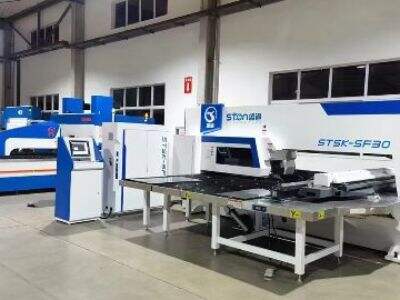Painotin on kone, jolla on tärkeä rooli metallinsyöttöalalla. Se toimii periaatteessa niin, että se taivuttaa tai kääntää metallilevyjä erilaisiin muotoihin. Parhaan painotimen valitseminen tehtaallasi voi olla monimutkainen ja hämmentävä. Siksi on tärkeää ottaa huomioon joitakin keskeisiä kysymyksiä ennen kuin teet päätöksen. Tämä opas vie sinua läpi joitakin tärkeimpiä harkintakriteereitä, jotta voit tehdä oikean valinnan parhaasta painotimesta.
Miten aloittaa painotimen valitsemisessa
On olemassa monta kriittistä tekijää, joita on otettava huomioon painotimen ostamisen yhteydessä:
Materiaalin tyyppi — Katsotaan materiaalien tyyppejä, joita käsittelet. Paino viittaa siihen, kuinka paljon voimaa tarvitaan erilaisten materiaalien kaarettamiseen. Esimerkiksi, jos käsittelet joustavia ja kevyitä metalleja, sinulla ei ole tarvetta raskas-ductility painepyhään. Jos kuitenkin liiketoimintasi käsittelee paksuja ja raskaita metalleja, sinun täytyy olla painepyyhti korkeammalla painolla. Siis ilmeisesti valitse malli, joka voi käsitellä metalia, jota työskentelet yleensä.
Paino: Paino tarkoittaa sitä, kuinka vahva painepyyhti on. Oikean painon painepyyhinnän valitseminen on ratkaisevan tärkeää liiketoimintasi tarpeisiin. Jos myymäläsi kaareuttaa vain kevyitä materiaaleja, voit hyvin valita painepyyhinnän, jolla on alempi paino. Jos kuitenkin työskentelet paksuilla ja raskaille materiaaleilla, sinulle tarvitaan vahvempi painepyyhti, joka voi käsitellä tällaisia materiaaleja.
Jakaja: Painopohjan pituus. Haluat varmasti painopohjan, joka on tarpeeksi pitkä tehdäksesi haluamasi kaarennukset. Pohjan kaarneyhteen pituus tulisi olla yhtä suuri tai suurempi kuin mitä yrityksesi vaatii. Näin voit tehdä kaarennukset yhdessä vaiheessa ilman ongelmia.
Akselien määrä: Akselit ovat koneen osia, jotka mahdollistavat metalin liikuttamisen ja kaarettamisen eri tavoin. Todellisen tarkkojen metalkaarennusten tapauksessa suositellaan vähintään neljällä akselilla varustettua painopohjaa. Nämä akselit ovat: X, Y, R ja Z -akseleita. Lisää akselia tarkoittaa tarkempaa kaarennustyötä.
Mikä tyyppi sopii sinulle parhaiten?
Kun asia on arvioitu, on aika tunnistaa se malli, joka täyttää yrityksesi tarpeet. Painopohjat jaetaan kolmeen pääluokkaan: hydrauliset, mekaaniset tai pneumaattiset.
Hydrauliset pohjaleikkurit ovat erittäin voimakkaita ja pystyvät siksi kaarettamaan korkeammassa tiheydessä olevia materiaaleja kuin muut tyypit. Niihin liittyy maine erittäin joustavista, tehokkaista ja tarkoista laitteista. Hydraulisiin pohjaleikkuriin on kaksi erilaista tyypejä: synkronoidut ja asynkronoidut. Synkronoiduissa hydraulisissa pohjaleikkureissa on useita sylinteröitä, jotka synkronoivat toimintansa varmistaakseen tasapainoisen paineen koko metalin pituuden yli, mikä johtaa parempiin kaaremuotoihin.
Mekaaniset pohjaleikkurit: Nämä sopivat kevyemmille kaarettamistehtäville. Ne ovat nopeita ja epähuomioituja, mikä tekee niistä suosittuja korkean nopeuden myymälöissä. On huomioitava, että mekaaniset pohjaleikkurit eivät välttämättä ole parhaita raskaille kaarettamistehtäville. Tämä tarkoittaa, että mekaaninen pohjaleikkuri ei ehkä ole sinulle erityisen hyödyllinen, jos työskentelet usein erikoismateriaaleilla, jotka ovat välttämättä melko paksuja.
Pneumaattiset kaarijousit: Pneumaattiset kaarijousit tarjoavat kaarettava voiman ilman paineella. Nämä ovat vain hyödyllisiä pienissä tehtävissä, jotka sisältävät kevyitä materiaaleja. Pneumaattiset kaarijousit ovat hyvä valinta yrityksille, joilla ei ole paljon voimaa käytössä tai jotka käyttävät jo ilmapurkujärjestelmiä. Ne täyttävät tarkoitustaan ja toimivat hyvin tietyillä aloilla.
Suurenna tonnikilo-kaarijousi työntekoon
Kun kyseessä on suurin mahdollinen tuottavuus toiminnassasi, oikean tonnikilon kaarijousin valitseminen on ehdottomasti ratkaisevan tärkeää. Alhaiset tonnikilot kaarijouset kuluttavat vähemmän energiaa, ja ne ovat yleensä edullisempia. Ne ovat tehokkaimpia ohuiten ja kevyiden materiaalien kaarettamiseen. Kuitenkin korkeat tonnikilot kaarijouset vievät enemmän energiaa ja maksavat enemmän, mutta antavat paljon voimaa, mikä mahdollistaa niiden käytön paksempien ja raskaiden materiaalien kanssa.
Lisäominaisuudet harkintakohdeksi
Edellä mainittujen keskeisten tekijöiden ohella tässä on joitakin muita ominaisuuksia, joita kannattaa ottaa huomioon kaarijousin valitsemisessa:
Tämä tarkoittaa, että kone on varustettu monilla ominaisuuksilla. Tämä järjestelmä tarjoaa tarkasti mittatun kaareutumiskulman. Suurin osa tästä ajasta johtuu epätasapainoisuuksista, jotka liittyvät itse kaareuttamisprosessiin, ja mies, joka tietää, että aika on raha, voi helposti ymmärtää tarvetta tarkalle takajousijärjestelmälle.
Työkalujärjestelmä ja imitointijärjestelmä — Toinen näkökohta, jota pitää etsiä, on työkalujärjestelmä ja imitointijärjestelmä. Hyvä työkalu- ja imitointijärjestelmä pystyy helposti suorittamaan erilaisia tehtäviä sekä varmistamaan, että kaaret ovat tasaisia ja juuri siellä, missä ne kuuluvat. Tämä on avainkoe lopputuotteiden korkealle laadulle.
Käyttöliittymä – Viimeiseksi harkitse käyttöliittymää. Helposti käytettävä käyttöliittymä auttaa käyttäjää hallitsemaan painotinriippuvuuksia koskevia toimintoja ja tekee sen virheettömäksi. Edistykselliset käyttöliittymät voivat myös auttaa toiminnoissa kuten ohjelmointiominaisuuksissa, automaattisissa kaareutuskulman laskennissa ja työkalujen hallinnassa.
 EN
EN
 AR
AR
 HR
HR
 CS
CS
 DA
DA
 NL
NL
 FI
FI
 FR
FR
 DE
DE
 EL
EL
 HI
HI
 IT
IT
 JA
JA
 KO
KO
 PT
PT
 RO
RO
 RU
RU
 ES
ES
 SV
SV
 ID
ID
 SR
SR
 SK
SK
 SL
SL
 UK
UK
 VI
VI
 HU
HU
 TR
TR
 FA
FA
 AF
AF
 MS
MS
 GA
GA
 IS
IS
 AZ
AZ
 EU
EU
 KA
KA
 BN
BN
 LO
LO
 LA
LA
 MN
MN
 NE
NE




